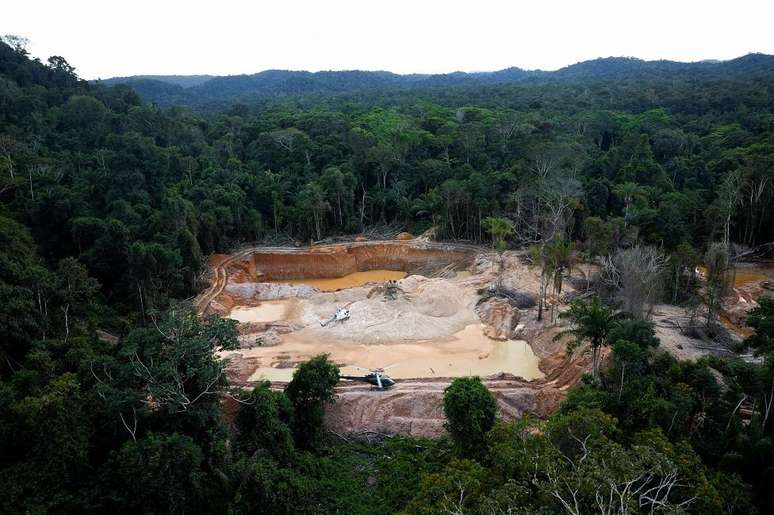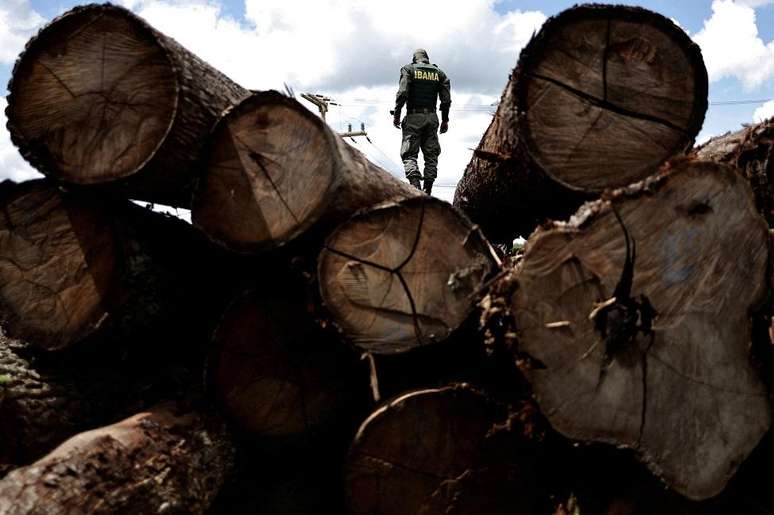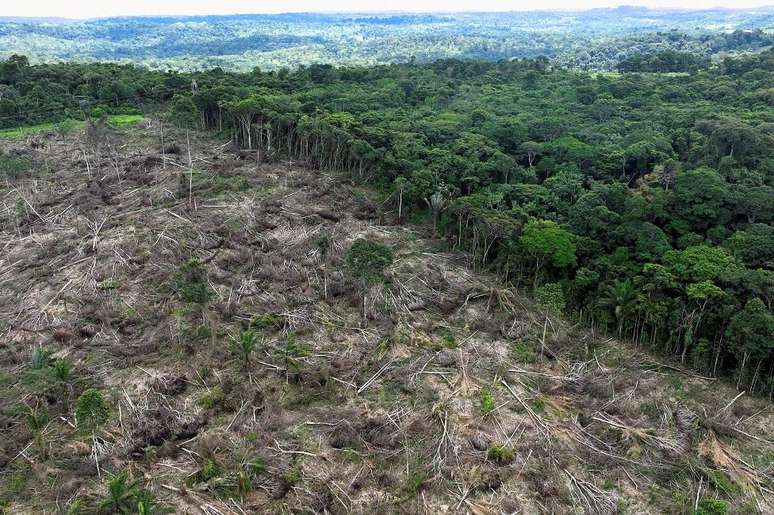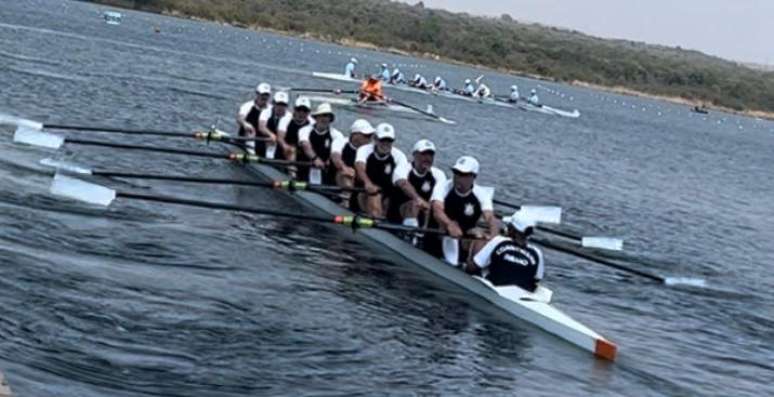According to geographer Aiala Colares Couto, criminal factions such as the CCP and the Vermelho Command are increasingly involved in illegal markets in the Amazon region. According to him, who investigates the violence in the north of the country, these criminal groups, from the south-east, are now operating in trafficking, land grabbing, but also in mining and illegal logging.
The actions of the factions controlling the drug trade are increasingly influencing the rise of environmental crimes in the Amazon, such as deforestation, land grabbing, mining on indigenous lands and illegal logging, according to geographer Aiala Colares Couto, researcher at the Brazilian Public Safety Forum.
A professor at the State University of Pará (UEPA), Colares Couto has even coined a term to explain this connection: narcoecology.
“There is a relationship between drug trafficking and environmental crimes. Drug trafficking acts as a partner and financier, because it has understood that these illegal networks are important for resource expansion and money laundering,” Couto explained, in a interview with BBC News Brasil last Saturday (11/3).
He is one of the authors of the study Cartographies of violence in the Amazon regionpublished by the Brazilian Public Security Forum at the end of last year.
One of the most worrying data from the survey is the exponential increase in violent deaths in the Amazon region. Between 1980 and 2019, the homicide rate grew 260 percent in Northern region states, while in the Southeast, this rate decreased 19 percent.
According to Couto, there are several explanations for the violence, such as conflicts over land, the growth of illegal markets and, more recently, the presence of criminal factions, both regional and from the Southeast.
In the latter case, the growth of the First Command of the Capital (PCC), which arose in the prisons of São Paulo, and of the Red Command, of Rio de Janeiro, is noteworthy.
According to the researcher, the CCP currently organizes and invests in trafficking routes through the Amazon according to a commercial logic: the goal, he says, is to transport cocaine to profitable markets in Europe. The Vermelho Command controls the territories and the sale of drugs in large cities and metropolitan regions.
“The Amazon is strategic for drug trafficking,” says the professor.
Born in Quilombo Menino Jesus de Petimandeua, in Inhangapi, Pará, geographer Aiala Colares Couto is also active in the black movement and coordinates the Nucleus of Afro-Brazilian Studies at the State University of Pará.
Read the interview below.
BBC News Brazil – What does the term “narcoecology” mean?
Aiala Colares Couto – Narcoecology is a concept that I created as a result of research conducted between 2020 and 2021. In this study, we analyze the connections of drug trafficking with environmental crimes.
We have noticed that there is an approximation between trafficking and the illegal logging market, land grabbing and mining in indigenous lands, especially in Roraima.
I understood that this dynamic relationship of the trafficking economy contributes to the advancement of environmental crimes, such as deforestation, pollution and reduction of biodiversity.
But this connection also contributes to the advancement of the political strength of drug trafficking itself, which has understood that these illegal networks are important for expanding its illicit resources and money laundering.
BBC News Brasil – Why is the Amazon important to factions like the CCP?
Couto necklaces – The Amazon is strategic for drug trafficking, as it is a transit region for cocaine and, more recently, skunk (a stronger type of marijuana). These drugs come from other countries that border Brazil, such as Peru and Bolivia, and travel through the Amazon to exit points bound for Europe.
Groups that previously operated only in the southeast, such as the CCP and the Vermelho Command, have gained strength in the north through alliances formed within the prison system.
The transfer of prisoners from one state to another has brought together members of Southeastern factions with members of regional groups.
This has led to the internalization of factions in different regions of the Amazon and also to the association of these groups with loggers and miners.
Trafficking is a partner and financier of these markets. In some places, such as Roraima, factions have expelled former miners and taken over the business.

BBC News Brasil – You commented that the Amazon is a transit region for cocaine from other countries. Where does this drug end up in Brazil?
Couto necklaces – Today, one of the main cocaine export points is Porto Vila do Conde, in Barcarena, Pará. This drug mainly goes to Europe.
In many of the port seizures, the cocaine was packed alongside the contraband timber. These groups make money on both sides, with drugs and wood.
BBC News Brasil – But how does the CCP behave in this transport?
Couto necklaces – There is a dispute over drug transport control.
One of the main entrances for cocaine of Peruvian origin is the valley of the Solimões River, which today is an area disputed by various groups, as it is not easy to dominate such a vast region. It is a very complex operation.
Previously, this point was controlled by the Nord Family, who lost the dispute to the Red Command. Currently those who travel part of this route is a group called Os Crias, but the PCC is also present.
What we have noticed is that the CCP works more with organizing these trafficking routes, so much so that it has members working in neighboring countries.
It has a transnational operation, in a more complex commercial logic, allowing cocaine to reach the most profitable markets in Europe.
With greater vigilance against trafficking in Europe, cocaine has become even more expensive. It’s an illicit business that generates a lot of money.

BBC News Brasil – Besides the CCP, there are other factions in the north of the country. How do they divide in the control of criminal activities?
Couto necklaces – As I said, the CCP acts more entrepreneurially, especially in Roraima and inland areas.
But I would say that the most hegemonic group in the Amazon is the Vermelho Command, which controls many territories with a guerrilla and urban warfare tactic. This happens mainly in large cities and metropolitan areas, such as Belém, Altamira and Parauapebas.
Here, the faction acts like a militia, charging merchants a monthly fee, paying bribes, but also controlling retail drug sales.
In Manaus, where the Familia do Norte was strongest, the Comando Vermelho is also becoming hegemonic.
The Northern Family has lost a lot of space in Manaus after the murders and arrests of several leaders. It’s practically extinct.
But other local groups have emerged, such as the Cartel do Norte, the Revolucionários do Amazonas and Os Crias, who are dissidents of the Familia do Norte, and who do not enter into conflict with the Vermelho Command.
BBC News Brasil – How do factions affect the lives of indigenous peoples?
Couto necklaces – There have already been cases of indigenous people being trafficked, going into debt and being murdered by the Red Command.
Drugs and alcoholism are serious problems in indigenous and quilombola communities.
There are many threats and psychological pressures, all kinds of violence imposed by an armed group that controls a territory.
BBC News Brasil – Implementing a mining system in remote regions, as has been the case on indigenous Yanomami land, is not cheap. It costs a lot of money to get and install the gold mining machines. How do factions participate in this system?
Couto necklaces – In 2018, there was an escape from the Boa Vista prison system. The detainees took refuge in the mining areas.
These points are located on federal land, where only the Federal Police, Ibama and ICMBio can enter. The Military and Civil Police, commanded by state governments, cannot act in these areas.
Mining became a place of refuge for CCP members and even leaders. It was then that members of the faction began working with gold smuggling and realized that it was important to control this business.
But not only.
They also began to control houses of prostitution and drug dealing.

BBC News Brazil – The number of homicides in the northern states has grown a lot in recent decades. What could be done to decrease this index?
Couto necklaces – The Amazon region is at the center of land disputes, an unresolved issue.
A decree from the time of the military dictatorship federalized many of these lands. They are areas of the Union and states and municipalities have no power over them.
These territories began to be contested by squatters and land grabbers, creating land conflicts that turned violent. It is a problem that needs to be fixed.
Another point is to increase public security personnel in faction-controlled areas.
The city of Altamira (PA), for example, has historically had environmental problems and territorial conflicts. And it has grown a lot in recent years, attracting factions such as the Vermelho Command.
Another issue is to solve the historical problem of demarcation of indigenous lands and to avoid exploitation by miners and loggers.
BBC News Brasil – Part of the Belém suburb has been controlled by militias led by police officers and former public safety officers. Does this situation continue?
Couto necklaces – The militias are now more camouflaged, they don’t show up like before, but they still exist.
In the neighborhood of Guamá, for example, we have the presence of seven militias that divide the territory. It is the only neighborhood on the outskirts of Belém where there is no Commando Vermelho graffiti prohibiting robberies in the community.
The militias also spread to cities in the Belém metropolitan region, such as Ananindeua, Santa Bárbara, Benevides and Castanhal.
Source: Terra
Rose James is a Gossipify movie and series reviewer known for her in-depth analysis and unique perspective on the latest releases. With a background in film studies, she provides engaging and informative reviews, and keeps readers up to date with industry trends and emerging talents.




![Everything starts here: What awaits you on May 2, 2025 in the 1167 Episode of Friday [SPOILERS] Everything starts here: What awaits you on May 2, 2025 in the 1167 Episode of Friday [SPOILERS]](https://fr.web.img5.acsta.net/img/be/b0/beb0b134b7640ff9b2fac5a0a5fab08e.jpg)



